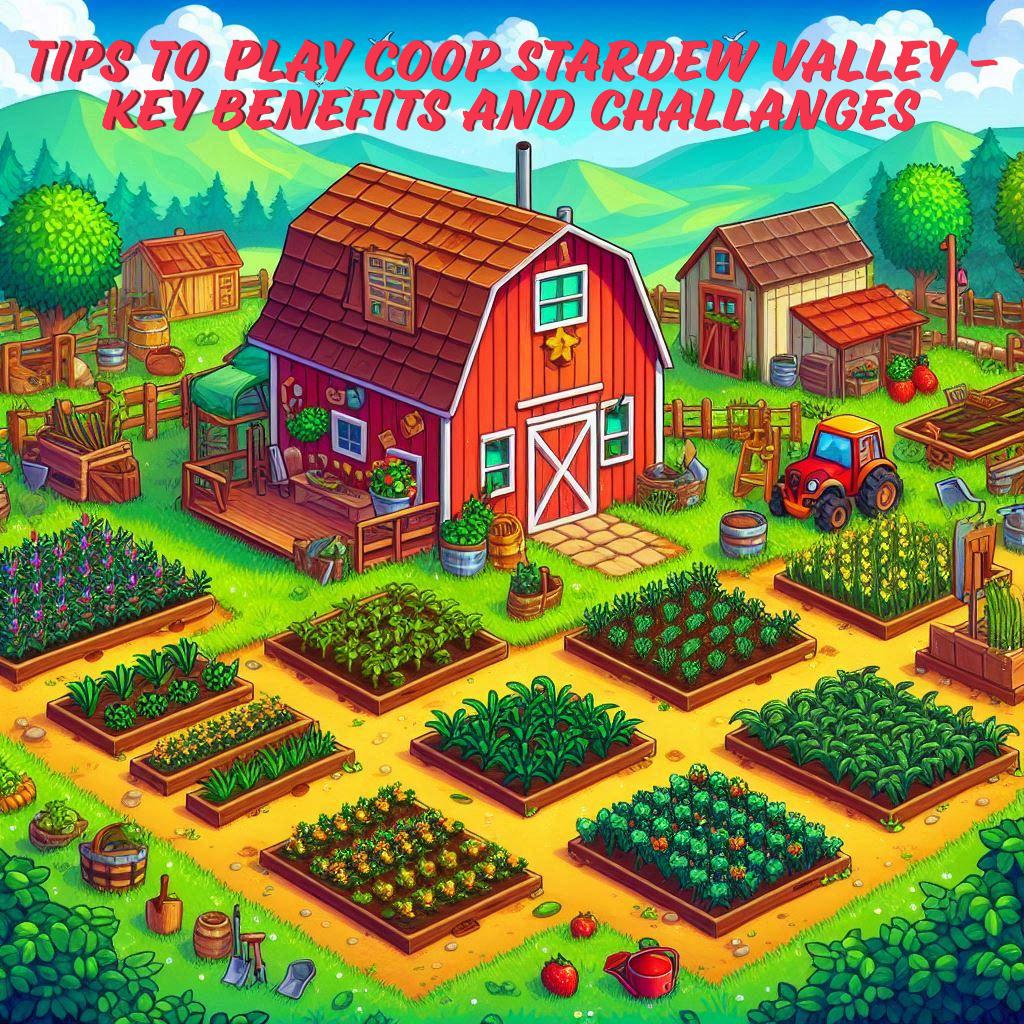Coops in Stardew Valley are essential farm buildings that allow players to raise various animals, including chickens, ducks, rabbits, and dinosaurs. To build a Coop, players must visit Robin at the Carpenter’s Shop, which is open from 9 AM to 5 PM. Once built, the basic Coop can house up to 4 chickens. Players can then choose a location on their farm for the Coop, which has a footprint of 6×3 tiles.
Players can purchase animals from Marnie’s Ranch, available every day except Mondays and Tuesdays, from 9 AM to 4 PM. Some animals, like dinosaurs, require special eggs that must be hatched in an incubator inside a Big or Deluxe Coop. Coops are a vital component of farm management in Stardew Valley, providing players with the opportunity to raise various animals and expand their farming operations as they progress through the game.
Types of Animals
The types of animals that can be housed in each Coop level
- Basic Coop: Chickens only
- Big Coop: Chickens, ducks, void chickens, golden chickens, and dinosaurs.
- Deluxe Coop: Chickens, ducks, void chickens, golden chickens, dinosaurs, and rabbits.
Age Level to Play Coop Stardew Valley
The recommended age to play Stardew Valley, including its co-op mode, is generally around 10 to 13 years old. The game is rated Everyone 10+ due to its mild themes and gameplay complexity. Stardew Valley is accessible to younger players, ages 10 to 13 are often considered ideal for independent play, with younger children benefiting from parental guidance. The game involves various mechanics such as farming, resource management, and social interactions, which can be complex for younger children.
Many parents suggest that children around 10 years old can grasp these mechanics effectively. While the game is colorful and generally peaceful, it does include some mature themes, such as alcohol consumption and character backstories that may raise questions among younger players. Many families play together, and younger children have been noted to enjoy the game, primarily engaging with simpler tasks like collecting items or caring for animals.
The Benefits of Upgrading my Coop
Upgrading your Coop provides more space for animals, introduces new animal types, includes an incubator to hatch eggs, adds an autofeed system, and increases interior space for storage. While the upgrade costs are high, the benefits make it a worthwhile investment for any serious farmer in Stardew Valley.
Increased Animal Capacity
- Big Coop holds up to 8 animals.
- Deluxe coop holds up to 12 animals.
New Animal Types
- Big coop adds ducks, void chickens, golden chickens, and dinosaurs.
- Deluxe coop adds rabbits.
Incubator
The Big Coop and Deluxe Coop both include an incubator that allows you to hatch eggs into animals, saving money compared to buying them from Marnie’s Ranch.
Autofeed System
The Deluxe Coop includes an autofeed system that automatically distributes hay from silos to your animals, saving time.
Increased Interior Space
The Deluxe Coop has more interior space than the lower tiers, allowing you to use it as a shed to store items.
Tips for Coop Stardew Valley
-
Build a Silo Before a Coop
It’s important to build a Silo before constructing a Coop. The Silo automatically stores hay when you cut grass, providing a steady supply of feed for your animals. Without a Silo, you’ll have to continuously buy hay from Marnie’s Ranch, which can be costly.
-
Upgrade the Coop
As your farm grows, consider upgrading your Coop. The Big Coop and Deluxe Coop offer more space for animals, allow you to raise new types like ducks and rabbits, and include features like an incubator and autofeed system. The upgrades require significant resources but can streamline animal care.
-
Collect Eggs and Mayo
Eggs are a valuable resource. You can sell them directly or use them to make mayonnaise, which sells for over 3 times the value of a single egg. Invest in a Mayo Machine to turn your eggs into a profitable product.
-
Divide Chores Among Players
In multiplayer, assign specific chores to each player to ensure all animals are cared for. This could involve feeding, collecting eggs, or processing products. Clear division of tasks helps maintain a productive farm.
-
Use Shared Chests
Create a communal chest area on your farm to store shared resources like animal products or feed. This ensures everyone can access what they need, even if a player is offline. Settle inventories before logging off to avoid items getting stuck with an absent player.
-
Enjoy the Immersion
Raising animals in a Coop adds a fun, immersive element to Stardew Valley. Watching your flock grow and collecting their products is a rewarding part of farm life. Embrace the joys of animal husbandry, but plan ahead to avoid early struggles with feed and housing.
The Benefits of Sharing Tools in Stardew Valley Multiplayer
Sharing tools in Stardew Valley multiplayer offers several benefits that enhance gameplay efficiency and collaboration among players. Sharing tools in Stardew Valley multiplayer not only streamlines gameplay but also fosters collaboration and efficiency, allowing players to make the most of their time on the farm.
-
Increased Efficiency
Players can focus on specific tasks without needing to carry every tool. For instance, if one player is mining, they can leave their farming tools in a shared chest for another player to use, allowing everyone to maximize their productivity.
-
Resource Management
With multiple players, you can coordinate tool upgrades more effectively. Since only one blacksmith is available for upgrades, sharing tools means that while one player’s tool is being upgraded, others can continue working without interruption.
-
Enhanced Exploration
When exploring areas like the mines or the beach, players can share tools that are not needed for their current tasks. For example, a player can leave a fishing rod or a hoe in a communal chest for others to use, promoting teamwork and exploration.
-
Flexibility in Gameplay
Players can adjust their strategies based on the tools available. If someone is using a tool for a specific task, others can adapt by taking on different roles, such as gathering resources or tending to animals.
-
Reduced Inventory Clutter
Sharing tools helps reduce the clutter in individual inventories. Players can keep only the tools they need for their immediate tasks, making it easier to manage resources and items.
-
Encourages Teamwork
Sharing tools promotes a sense of teamwork and collaboration among players. It encourages communication and planning, which can enhance the overall gaming experience.
Is Coop Stardew Valley Free or Paid
Stardew Valley is a paid game, and the co-op feature is included within the game itself. The game itself is not free, the co-op mode is part of the game you purchase, and you will need to invest in in-game resources to build and upgrade Coops for animal husbandry.
-
Game Purchase
To play Stardew Valley, you need to purchase it. The price varies depending on the platform:
-
- PC – Typically around $14.99 on platforms like Steam or GOG.
- Consoles – Prices are similar, generally around $14.99 on Nintendo Switch, PlayStation, and Xbox.
- Mobile – The game costs about $4.99 on iOS and Android devices.
-
Coop Construction
Within the game, if you want to build a Coop to house animals, it costs 4,000 gold, along with 300 wood and 100 stone. Upgrading the Coop to a Big or Deluxe Coop incurs additional costs and materials.
Key Challenges of Playing Stardew Valley with Younger Kids
Playing Stardew Valley with younger kids can be a rewarding experience, but it also comes with several challenges. Stardew Valley offers a fun and engaging experience for younger players, challenges such as technical issues, understanding game mechanics, emotional dynamics, time management, and online safety need to be addressed to ensure a positive gaming experience. Parents can help by guiding gameplay, setting boundaries, and fostering a supportive environment. Here are the main difficulties parents and guardians might encounter:
-
Technical Challenges
- Younger players may struggle with the technical aspects of joining multiplayer games. Issues with invite codes and game setup can lead to frustration, especially if they feel they are not as adept as older players, which can affect their confidence and enjoyment of the game.
-
Understanding Game Mechanics
- The game involves various mechanics such as farming, resource management, and social interactions. Younger children may find it difficult to grasp these concepts fully, which could lead to confusion or a feeling of being overwhelmed.
-
Emotional and Social Dynamics
- While Stardew Valley is designed for cooperative play, younger kids may experience feelings of inadequacy if they are not performing as well as older players. This can result in frustration or a lack of engagement in the game. The game includes elements of relationships, marriage, and family dynamics within the village, which may not be fully understood by younger players. This could lead to uncomfortable questions or misunderstandings about the themes presented.
-
Time Management
- Managing how much time kids spend playing can be a challenge. The game is engaging and can lead to extended play sessions, which may interfere with other activities or responsibilities.




